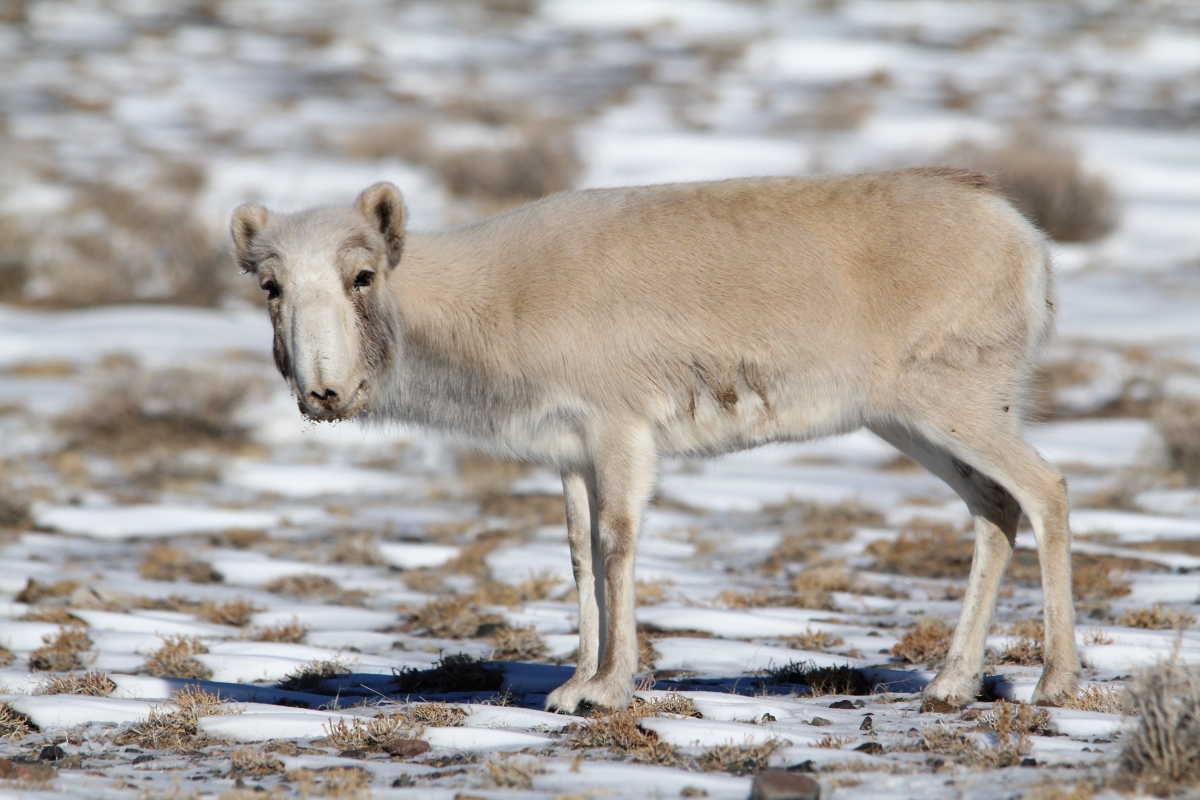Press Releases Archive
22.03.2017
New Hope for the Saiga Antelope?
Saiga Antelopes were much more flexible than originally thought.
Senckenberg scientists have discovered that the Saiga Antelope, which is currently threatened with extinction, used to be much more flexible in its habitat and food choices in the past than previously assumed. Based on carbon and nitrogen isotopes in the collagen from the antelopes’ bones, the scientists compared the diets of fossil versus modern-day Saiga. In their study, recently published in the scientific journal “Quaternary Science Reviews,” they reached the conclusion that today’s populations are not obligatorily bound to their current habitat. This insight offers new hope for this endangered species.
During the last Ice Age, Saiga Antelopes were widespread throughout the northern hemisphere and migrated across the tundra in the company of mammoths. Today, these animals with their characteristic, trunk-like noses are only found in Central Asia and Russia. “We were interested in finding out why the Saiga’s habitat is so much more restricted today than during the period between 45,000 and 10,0000 years ago,” explains Professor Dr. Hervé Bocherens of the Senckenberg Center for Human Evolution and Palaeoenvironment (HEP) at the University of Tübingen, and he continues, “Were the animals back then better able to adapt to various environmental conditions, or is it possible that the modern antelopes are not necessarily bound to their current habitat?”
This question, which the biogeologist from Tübingen explored together with his colleague, Dr. Dorothée Drucker, and an international team, was raised against a serious background: The Saiga Antelope is threatened with extinction. Already heavily decimated by poaching, the populations are additionally threatened by recurring virus infections. Since the beginning of this year, 2,500 animals have already died in Chowd-Aimag Province in Western Mongolia – one fourth of the entire Mongolian population. “If today’s Saiga Antelopes – like their Ice Age ancestors – were able to survive outside of semi-arid steppes, the danger of such an epidemic would not be nearly as grave,” explains Drucker.
To examine this possibility, the research team compared the composition of carbon and nitrogen isotopes in the collagen from 76 fossilized and 52 recent bones and hairs of Saiga Antelopes. Collagen is an essential organic component of the tissue in bones, teeth, cartilage, tendons, ligaments and the skin. The isotope composition in the bones’ collagen offers insights into the animals’ feeding habits.
“Contrary to what we assumed before, the diet of the Saiga during the last Ice Age was much more flexible than that of their modernday relatives – we therefore assume that the recent Saiga Antelopes only occupy one of their potential ecological niches,” explains Bocherens and offers in conclusion, “Being able to move into other, including colder, areas would offer great opportunities for the Saiga’s protection. This should be taken into account when developing conservation programs.”
Contact
Prof. Dr. Hervé Bocherens
Dr. Dorothée Drucker
Senckenberg Center for Human Evolution and Palaeoenvironment (HEP)
Eberhard Karls Universität Tübingen
Phone 07071- 29-76988
<link>herve.bocherens@uni-tuebingen.de
<link>dorothee.drucker@ifu.uni-tuebingen.de
Judith Jördens
Press Office
Senckenberg Gesellschaft für Naturforschung
Phone 069- 7542 1434
<link>pressestelle@senckenberg.de
Publication
Jonathan Jürgensen, Dorothée G. Drucker, Anthony J. Stuart, Matthias Schneider, Bayarbaatar Buuveibaatar, Hervé Bocherens, Diet and habitat of the saiga antelope during the late Quaternary using stable carbon and nitrogen isotope ratios, Quaternary Science Reviews, Volume 160, 15 March 2017, Pages 150-161, ISSN 0277-3791, <link http: dx.doi.org j.quascirev.2017.01.022>dx.doi.org/10.1016/j.quascirev.2017.01.022.
 |  |
| Fossilized skull of a Saiga Antelope from Alaska. © Anthony Stuart | During the last Ice Age, the Saiga was still widespread; today, they are restricted to Central Asia and Russia. The photo shows a diorama at the Senckenberg Nature Museum in Frankfurt. © Senckenberg |
The Senckenberg Gesellschaft für Naturforschung
To study and understand nature with its unlimited diversity of living creatures and to preserve and manage it in a sustainable fashion as the basis of life for future generations – that has been the goal of the Senckenberg Gesellschaft für Naturforschung (Senckenberg Nature Research Society) for almost 200 years. This integrative “geobiodiversity research” and the dissemination of research and science are among Senckenberg’s primary tasks. Three nature museums in Frankfurt, Görlitz and Dresden display the diversity of life and the earth’s development over millions of years. The Senckenberg Gesellschaft für Naturforschung is a member of the Leibniz Association. The Senckenberg Nature Museum in Frankfurt is supported by the City of Frankfurt am Main as well as numerous other partners. Additional information can be found at <link http: www.senckenberg.de>www.senckenberg.de.
The University of Tübingen
The University of Tübingen is one of eleven German universities that received the recognition of excellence. Within the field of life sciences, it offers cuttingedge research in the areas of neurosciences, transnational immunology and cancer research, microbiology and infection research as well as molecular biology. Additional focal areas include geological and environmental research, archeology and anthropology, language and cognition as well as education and media. More than 28,400 students from all over the world are currently enrolled at the University of Tübingen. They can avail themselves of a wide spectrum of approximately 300 study courses – from Egyptology to Cellular Neurosciences.

